





PHOTO GALLERY

Photos by Len Blumin
1. Heermanns' Gull (1st summer)
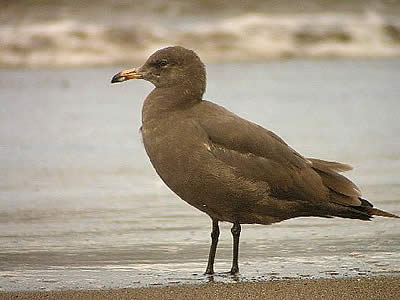
Many members of the gull family (Order: Charadriiformes; Family: Laridae) are widely
distributed, but Heermann's Gull is rather limited in its range. After breeding in Baja California and along the mainland
of Mexico, most head north to feed along coastal California, and have been appearing the good
number the past 2 weeks. Today I watched a flock of several hundred at Stinson Beach,
California. Unmistakable in all plumages, and handsome they are. The first summer birds are a
tad brownish, with a bill that is yellow at the base.
Swaro ST80, 30x SW, CP 8400. Minimal PS,
no crop.
2. Heermann's Gull (adult breeding)
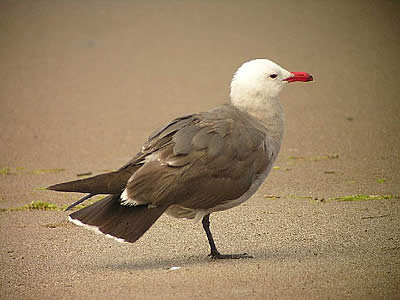
Now this is one smartly decked out gull! Right now they are just hanging out on the beach, but
will soon join the Brown Pelicans in their feeding forays, hoping to catch the fish that slip out of
the pelican's pouch. White head, gray body, dark back, and of course the striking red bill.
Stinson Beach, Swaro 80, 30x SW, DCA, CP 8400
3. Heermann's Gull (2nd summer)
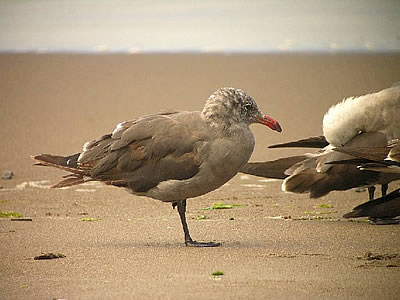
To complete the series on summer Heermann's Gull in California, this bird has the red bill, but
hasn't developed the white head of the full adult, so I believe it is a second summer plumage (2+
year old bird). Wouldn't it be great if other gulls could be as distinctive, even as sub-adults!
Swaro 80, 30x, DCA, CP 8400, minimal PS
4. Willet
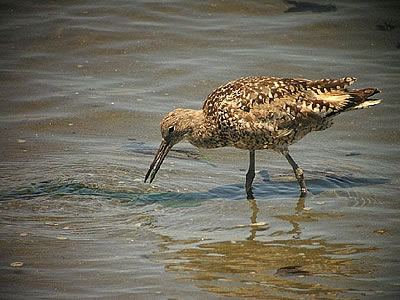
Willet in alternate (breeding) plumage at Bodega Bay. When I posted this on "Birds'-Pix" (a YahooGroups bird site) I learned from an email that the name had been changed to Tringa semipalmata. Now that's a lot easier to write than Catoptrophorus... and makes a whole lot more sense, since it has always been classified as a Tringa anyway.
5. Lava Gull
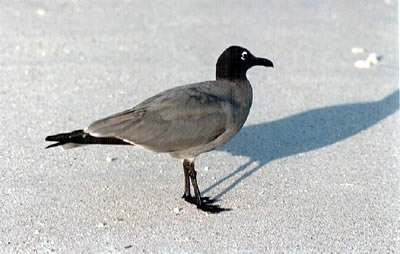
Well, this year we've decided to tackle the gulls, as you might have guessed. No easy task, but gulls hang out on the beach a lot and let you take a good look, so there's hope. In 1990 Patti and I spent two weeks in the Galapagos with friends. We weren't into birding at the time, but we did bring a camera. I took this shot with an old Minolta SLR and 210 mm telephoto lens. What you see is a scan of a 4 x 6 print made after the trip, so please excuse the defects.
The Lava Gull is a Galapagos endemic species, so you won't find it anywhere else. There are said to be only 400 pair of Lava Gulls left, or something like that, making this truly a "rare bird". Many gulls and shorebirds have 'counter-shading', referring to darker colors on the back and lighter color on the ventral side (belly, etc.). This is said to make them blend in better, as the sun will lighten the back and the shaded white of the belly will blend with the sand. Well, in the Galapagos there's a lot more lava than sand, so no need for a light belly! This must be one of the darkest of all gulls, with black head, black bill and feet, and general dark gray all over. But the eye arcs give it a measure of distinction, recalling the Laughing Gull, to which it is said to be closely related.
6. Swallow-tailed Gull ("He's not heavy, he's my lover")
Back to order Charadiiformes (this time with 2 i's - thanks Ray) and the family Gulls. The Swallow-tailed Gull, Creagus furcatus, is the only species in the Creagus genus. Which makes Creagus a "monotypic" genus. These beautiful gulls breed almost exclusively in the Galapagos Islands, but in winter they forage along the west coast of South America. You can read about them in a great book by M.H. Jackson, "Galapagos - A Natural History Guide". Among other tidbits, I learned they forage on the open sea at night (for squid and fish on the surface), and return to the nest with food in near total darkness. Well, the chicks would have trouble locating a black bill in darkness, so they evolved a white tip on the bill for the chicks to seek out and stimulate the parent to regurgitate the partly digested morsel. (I hope you've finished dinner by now....).
Okay, dinner done, but those with naive kids (or is that no longer a meaningful phrase) may want to divert them from the following photo, also taken during our April 1990 trip to the Galapagos with friends from ACR.
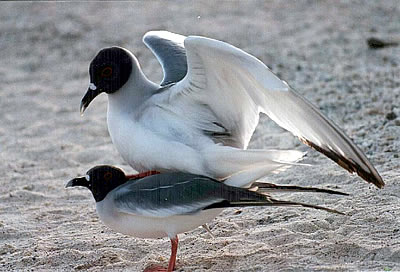
The black head and red feet are obvious, as well as the white patch at the base of the bill. Less
obvious in the photo are the white tip on the bill, the bright red-orange eye ring, and the
swallow-like notched tail (seen only in flight). I know that the male appears much larger than the
female, and there is probably some true size difference, but sometimes posture and activity can
exaggerate such differences, as other photos we took shows less of a disparity.
Photo with
Minolta SLR, print film, 210mm tele.
So where do I get all this esoterica? I check books like Jackson's, and websites like Seabirds of the World: http://www.oceanwanderers.com/GullsList.html (great photos and links).
Lastly, this species has been documented to occur in California, as least on one occasion in Monterrey in June 1985. See http://www.wfo-cbrc.org/cbrc/photos/index.html (good website for documented rare bird sightings in California).
TOWHEE.NET: Harry Fuller, 820 NW 19th Street, McMinnville, OR 97128
website@towhee.net